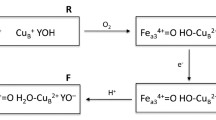Abstract
The pH dependence of the redox potentials in the tetrahemic cytochrome c 3 from Desulfovibrio vulgaris Hildenborough (redox-Bohr effect) is here investigated using continuum electrostatics methods. The redox-Bohr effect seems to be associated with changes in the protonation state of charged residues in the protein, but the exact residues had not been identified. The global pK a of this phenomenon is dependent on the redox state of the molecule, and the influence of the pH on the microscopic potential of each heme has been experimentally quantified. The availability of detailed experimental data provides us with important and unique guides to the performance of ab initio pK a calculations aiming at the identification of the groups involved. These calculations were performed in several redox states along the reduction pathway, with the double objective of finding groups with redox-linked pK a shifts, and absolute pK as compatible with the redox-Bohr effect. The group with the largest pK a shift along the reduction pathway is propionate D from heme I. Its effect on the redox potential of individual hemes, as calculated by electrostatic calculations, correlates very well with the experimental order of influence, making it a likely candidate. Abnormal titration of the same propionate has been experimentally observed on a homologous cytochrome c 3 from a different strain, thus strengthening the theoretical result. However, its absolute calculated pK a in the fully oxidised cytochrome is outside the zone where the phenomenon is known to occur, but the calculation shows a strong dependence on small conformational changes, suggesting large uncertainties in the calculated value. A group with a pK a value within the experimentally observed range is propionate D from heme IV. Its influence on the redox potential of the hemes does not correlate with the experimental order, indicating that, although it may be one of the possible players on the phenomenon, it cannot be solely responsible for it. Mutation of the Lys45 residue is suggested as an indirect way of probing the importance of the propionate D from heme I in the mechanism. Non-heme groups may also be involved in this process; our calculations indicate His67 and the N-terminal as groups that may play a role. Accuracy and applicability of current continuum electrostatic methods are discussed in the context of this system.
Similar content being viewed by others
Author information
Authors and Affiliations
Additional information
Received: 27 March 1997 / Accepted: 19 August 1997
Rights and permissions
About this article
Cite this article
Soares, C., Martel, P. & Carrondo, M. Theoretical studies on the redox-Bohr effect in cytochrome c 3 from Desulfovibrio vulgaris Hildenborough. JBIC 2, 714–727 (1997). https://doi.org/10.1007/s007750050188
Issue Date:
DOI: https://doi.org/10.1007/s007750050188




